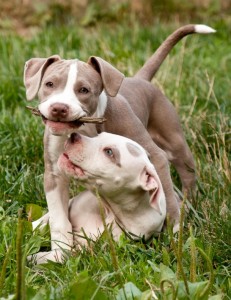
We hear about the importance of socializing our dogs and puppies to new things, but what exactly does that mean?
At what age should we begin exposing our puppies to new places and other dogs, and how can we go about it without scaring them or exposing them to diseases?
I reached out to some professionals for their ideas on how to socialize a puppy safely. Here’s what they had to say.
Tips for socializing your puppy
Allow the puppy to stay with his litter for 8 weeks
“A large amount of early socialization takes place with littermates,” said Dr. Danel Grimmett, a veterinarian with Sunset Veterinary Clinic in Edmond, OK. Because of this, it’s important for puppies to stay with their siblings for at least 8 weeks.
In this safe environment, puppies explore each other and learn key social cues such as bite inhibition and mutual grooming, Grimmett said.
“This ‘nursery’ experience helps them learn how to play with others and gives them confidence.”
Avoid busy pet areas until the puppy is vaccinated
Grimmett recommends puppies stay away from dog parks, large retail stores and other busy pet areas until they are fully vaccinated at about 3 to 4 months old.
Still, there are other ways to socialize your young puppy safely.
For example, if you have close neighbors with fully vaccinated pets, Grimmett said it’s OK to allow monitored play times.
Michelle Yue is a professional dog trainer with Good Dog DC in Washington, D.C., and she said one way to socialize your puppy before he's fully vaccinated is to carry him places. She likes to carry her puppies with her in a Sherpa bag.
“A lot of people think puppies need to touch things to become socialized,” she said. “They don't always need to make contact. Just looking, smelling and hearing are also great socialization.”
Enroll in a puppy "kindergarten" class
Yue recommends a quality “puppy kindergarten” class for socialization as long as it follows a sanitation protocol. There, your puppy will get safe play with other puppies and meet lots of new people. Plus, an added benefit is the puppy will be tired for a few hours after class!
Think ahead and create a plan accordingly
Make a list of everything you would want your adult dog to be OK with, Yue said.
This could be bikes, cars, cats, kids, farms, train stations, dog parks, etc.
Yue said to come up with a plan so you can introduce your puppy to various components of these things regularly.
Of course, don't go without puppy ID tags!
Introduce your puppy to a variety of people.
Yue also recommends new puppy owners invite a lot of people over.
“A new puppy is the perfect reason to entertain,” she said. “Having people over to your house will give your puppy lots of exposure to people and calm, friendly, adult dogs in a safe way.”
Watch for signs of stress
The puppy's body language will show you if she's being pushed too far, Grimmett said.
"Cowering, crying, running and hiding, having 'accidents' and in general appearing stressed are all clues to let you know they are not feeling safe and confident."
Other signs of mild stress to look for include yawning, lip licking, sneezing or looking away, Yue said. A little stress is fine, but it may mean your puppy needs a little more work in certain situations.
"Next time, keep a little distance and bring really tasty treats or a fun toy," she said.
Don't push the puppy too far.
Whenever possible, Yue said she likes to let the puppy go at her own pace.
For example, instead of having someone approach the puppy, Yue said she has the person stop a couple feet away and then hands him a high-value treat such as a piece of chicken. Usually this will get the puppy interested.
When the puppy approaches, Yue said she likes to use a 3-second rule for petting.
“New people should pet for 3 seconds, then stop,” she said. “If the puppy re-engages them by re-approaching, jumping, licking or nudging, pet again! If the puppy walks away, or ignores them, it probably means the puppy is ready to move on.”
What are some of your puppy socialization tips?

